Giant Photoluminescence Enhancement and Carrier Dynamics in MoS2 Bilayers with Anomalous Interlayer Coupling
Abstract
:1. Introduction
2. Materials and Methods
2.1. Sample Preparation
2.2. PL, Raman and Pump-Probe Measurements
3. Results and Discussion
3.1. Optical Properties of MoS2 Bilayers with Normal Interlayer Coupling
3.2. PL Enhancement in MoS2 Bilayers with Anomalous Interlayer Coupling
3.3. Carrier Dynamics in MoS2 Bilayers with Anomalous Interlayer Coupling
4. Conclusions
Author Contributions
Funding
Data Availability Statement
Acknowledgments
Conflicts of Interest
References
- Wang, J.; Li, H.; Ma, Y.; Zhao, M.; Liu, W.; Wang, B.; Wu, S.; Liu, X.; Shi, L.; Jiang, T.; et al. Routing Valley Exciton Emission of a WS2 Monolayer via Delocalized Bloch Modes of In-Plane Inversion-Symmetry-Broken Photonic Crystal Slabs. Light Sci. Appl. 2020, 9, 148. [Google Scholar] [CrossRef] [PubMed]
- Wu, S.; Buckley, S.; Jones, A.M.; Ross, J.S.; Ghimire, N.J.; Yan, J.; Mandrus, D.G.; Yao, W.; Hatami, F.; Vučković, J.; et al. Control of Two-Dimensional Excitonic Light Emission via Photonic Crystal. 2D Mater. 2014, 1, 011001. [Google Scholar] [CrossRef] [Green Version]
- Gan, X.; Gao, Y.; Fai Mak, K.; Yao, X.; Shiue, R.-J.; van der Zande, A.; Trusheim, M.E.; Hatami, F.; Heinz, T.F.; Hone, J.; et al. Controlling the Spontaneous Emission Rate of Monolayer MoS2 in a Photonic Crystal Nanocavity. Appl. Phys. Lett. 2013, 103, 181119. [Google Scholar] [CrossRef] [Green Version]
- Liu, C.-H.; Clark, G.; Fryett, T.; Wu, S.; Zheng, J.; Hatami, F.; Xu, X.; Majumdar, A. Nanocavity Integrated van Der Waals Heterostructure Light-Emitting Tunneling Diode. Nano Lett. 2017, 17, 200–205. [Google Scholar] [CrossRef]
- Zhang, X.; Choi, S.; Wang, D.; Naylor, C.H.; Johnson, A.T.C.; Cubukcu, E. Unidirectional Doubly Enhanced MoS2 Emission via Photonic Fano Resonances. Nano Lett. 2017, 17, 6715–6720. [Google Scholar] [CrossRef] [PubMed]
- Paik, E.Y.; Zhang, L.; Burg, G.W.; Gogna, R.; Tutuc, E.; Deng, H. Interlayer Exciton Laser of Extended Spatial Coherence in Atomically Thin Heterostructures. Nature 2019, 576, 80–84. [Google Scholar] [CrossRef] [Green Version]
- Wu, S.; Buckley, S.; Schaibley, J.R.; Feng, L.; Yan, J.; Mandrus, D.G.; Hatami, F.; Yao, W.; Vučković, J.; Majumdar, A.; et al. Monolayer Semiconductor Nanocavity Lasers with Ultralow Thresholds. Nature 2015, 520, 69–72. [Google Scholar] [CrossRef] [PubMed] [Green Version]
- Zhang, X.; De-Eknamkul, C.; Gu, J.; Boehmke, A.L.; Menon, V.M.; Khurgin, J.; Cubukcu, E. Guiding of Visible Photons at the Ångström Thickness Limit. Nat. Nanotechnol. 2019, 14, 844–850. [Google Scholar] [CrossRef]
- Dibos, A.M.; Zhou, Y.; Jauregui, L.A.; Scuri, G.; Wild, D.S.; High, A.A.; Taniguchi, T.; Watanabe, K.; Lukin, M.D.; Kim, P.; et al. Electrically Tunable Exciton–Plasmon Coupling in a WSe2 Monolayer Embedded in a Plasmonic Crystal Cavity. Nano Lett. 2019, 19, 3543–3547. [Google Scholar] [CrossRef]
- Wang, Q.H.; Kalantar-Zadeh, K.; Kis, A.; Coleman, J.N.; Strano, M.S. Electronics and Optoelectronics of Two-Dimensional Transition Metal Dichalcogenides. Nat. Nanotechnol. 2012, 7, 699–712. [Google Scholar] [CrossRef]
- Fiori, G.; Bonaccorso, F.; Iannaccone, G.; Palacios, T.; Neumaier, D.; Seabaugh, A.; Banerjee, S.K.; Colombo, L. Electronics Based on Two-Dimensional Materials. Nat. Nanotechnol. 2014, 9, 768–779. [Google Scholar] [CrossRef] [PubMed]
- Jariwala, D.; Sangwan, V.K.; Lauhon, L.J.; Marks, T.J.; Hersam, M.C. Emerging Device Applications for Semiconducting Two-Dimensional Transition Metal Dichalcogenides. ACS Nano 2014, 8, 1102–1120. [Google Scholar] [CrossRef] [Green Version]
- Radisavljevic, B.; Whitwick, M.B.; Kis, A. Integrated Circuits and Logic Operations Based on Single-Layer MoS2. ACS Nano 2011, 5, 9934–9938. [Google Scholar] [CrossRef] [PubMed]
- Zhang, H.; Shi, B.; Xu, L.; Yan, J.; Zhao, W.; Zhang, Z.; Zhang, Z.; Lu, J. Sub-5 nm Monolayer MoS2 Transistors toward Low-Power Devices. ACS Appl. Electron. Mater. 2021, 3, 1560–1571. [Google Scholar] [CrossRef]
- Lopez-Sanchez, O.; Lembke, D.; Kayci, M.; Radenovic, A.; Kis, A. Ultrasensitive Photodetectors Based on Monolayer MoS2. Nat. Nanotechnol. 2013, 8, 497–501. [Google Scholar] [CrossRef]
- Zeng, H.; Dai, J.; Yao, W.; Xiao, D.; Cui, X. Valley Polarization in MoS2 Monolayers by Optical Pumping. Nat. Nanotechnol. 2012, 7, 490–493. [Google Scholar] [CrossRef]
- Mak, K.F.; He, K.; Shan, J.; Heinz, T.F. Control of Valley Polarization in Monolayer MoS2 by Optical Helicity. Nat. Nanotechnol. 2012, 7, 494–498. [Google Scholar] [CrossRef]
- Gong, Z.; Liu, G.-B.; Yu, H.; Xiao, D.; Cui, X.; Xu, X.; Yao, W. Magnetoelectric Effects and Valley-Controlled Spin Quantum Gates in Transition Metal Dichalcogenide Bilayers. Nat. Commun. 2013, 4, 2053. [Google Scholar] [CrossRef] [PubMed] [Green Version]
- Jiang, T.; Liu, H.; Huang, D.; Zhang, S.; Li, Y.; Gong, X.; Shen, Y.-R.; Liu, W.-T.; Wu, S. Valley and Band Structure Engineering of Folded MoS2 Bilayers. Nat. Nanotechnol. 2014, 9, 825–829. [Google Scholar] [CrossRef] [PubMed]
- Zhu, B.; Zeng, H.; Dai, J.; Gong, Z.; Cui, X. Anomalously Robust Valley Polarization and Valley Coherence in Bilayer WS2. Proc. Natl. Acad. Sci. USA 2014, 111, 11606. [Google Scholar] [CrossRef] [PubMed] [Green Version]
- Wang, Y.; Cong, C.; Shang, J.; Eginligil, M.; Jin, Y.; Li, G.; Chen, Y.; Peimyoo, N.; Yu, T. Unveiling Exceptionally Robust Valley Contrast in AA- and AB-Stacked Bilayer WS2. Nanoscale Horiz. 2019, 4, 396–403. [Google Scholar] [CrossRef]
- Su, H.; Wei, C.; Deng, A.; Deng, D.; Yang, C.; Dai, J.-F. Anomalous Enhancement of Valley Polarization in Multilayer WS2 at Room Temperature. Nanoscale 2017, 9, 5148–5154. [Google Scholar] [CrossRef]
- Nayak, P.K.; Lin, F.-C.; Yeh, C.-H.; Huang, J.-S.; Chiu, P.-W. Robust Room Temperature Valley Polarization in Monolayer and Bilayer WS2. Nanoscale 2016, 8, 6035–6042. [Google Scholar] [CrossRef] [PubMed]
- Geim, A.K.; Grigorieva, I.V. Van Der Waals Heterostructures. Nature 2013, 499, 419–425. [Google Scholar] [CrossRef]
- Han, S.W.; Kwon, H.; Kim, S.K.; Ryu, S.; Yun, W.S.; Kim, D.H.; Hwang, J.H.; Kang, J.-S.; Baik, J.; Shin, H.J.; et al. Band-Gap Transition Induced by Interlayer van Der Waals Interaction in MoS2. Phys. Rev. B 2011, 84, 045409. [Google Scholar] [CrossRef]
- Mak, K.F. Atomically Thin MoS2: A New Direct-Gap Semiconductor. Phys. Rev. Lett. 2010, 105, 136805. [Google Scholar] [CrossRef] [Green Version]
- Kadantsev, E.S.; Hawrylak, P. Electronic Structure of a Single MoS2 Monolayer. Solid State Commun. 2012, 152, 909–913. [Google Scholar] [CrossRef]
- Han, L.; Jiajun, W.; Yating, M.; Jiao, C.; Xiang’ai, C.; Lei, S.; Tian, J. Enhanced Directional Emission of Monolayer Tungsten Disulfide (WS2) with Robust Linear Polarization via One-Dimensional Photonic Crystal (PhC) Slab. Nanophotonics 2020, 9, 4337–4345. [Google Scholar]
- Li, H.; Zheng, X.; Liu, Y.; Zhang, Z.; Jiang, T. Ultrafast Interfacial Energy Transfer and Interlayer Excitons in the Monolayer WS2/CsPbBr3 Quantum Dot Heterostructure. Nanoscale 2018, 10, 1650–1659. [Google Scholar] [CrossRef]
- Sarkar, S.; Mathew, S.; Chintalapati, S.; Rath, A.; Panahandeh-Fard, M.; Saha, S.; Goswami, S.; Tan, S.J.R.; Loh, K.P.; Scott, M.; et al. Direct Bandgap-like Strong Photoluminescence from Twisted Multilayer MoS2 Grown on SrTiO3. ACS Nano 2020, 14, 16761–16769. [Google Scholar] [CrossRef]
- Dhall, R.; Neupane, M.R.; Wickramaratne, D.; Mecklenburg, M.; Li, Z.; Moore, C.; Lake, R.K.; Cronin, S. Direct Bandgap Transition in Many-Layer MoS2 by Plasma-Induced Layer Decoupling. Adv. Mater. 2015, 27, 1573–1578. [Google Scholar] [CrossRef]
- Desai, S.B.; Seol, G.; Kang, J.S.; Fang, H.; Battaglia, C.; Kapadia, R.; Ager, J.W.; Guo, J.; Javey, A. Strain-Induced Indirect to Direct Bandgap Transition in Multilayer WSe2. Nano Lett. 2014, 14, 4592–4597. [Google Scholar] [CrossRef]
- Li, Z.; Lv, Y.; Ren, L.; Li, J.; Kong, L.; Zeng, Y.; Tao, Q.; Wu, R.; Ma, H.; Zhao, B.; et al. Efficient Strain Modulation of 2D Materials via Polymer Encapsulation. Nat. Commun. 2020, 11, 1151. [Google Scholar] [CrossRef] [Green Version]
- Yang, S.; Chen, Y.; Jiang, C. Strain Engineering of Two-Dimensional Materials: Methods, Properties, and Applications. InfoMat 2021, 3, 397–420. [Google Scholar] [CrossRef]
- He, Z.; Sheng, Y.; Rong, Y.; Lee, G.-D.; Li, J.; Warner, J.H. Layer-Dependent Modulation of Tungsten Disulfide Photoluminescence by Lateral Electric Fields. ACS Nano 2015, 9, 2740–2748. [Google Scholar] [CrossRef] [PubMed]
- van der Zande, A.M.; Kunstmann, J.; Chernikov, A.; Chenet, D.A.; You, Y.; Zhang, X.; Huang, P.Y.; Berkelbach, T.C.; Wang, L.; Zhang, F.; et al. Tailoring the Electronic Structure in Bilayer Molybdenum Disulfide via Interlayer Twist. Nano Lett. 2014, 14, 3869–3875. [Google Scholar] [CrossRef] [PubMed]
- Zheng, S.; Sun, L.; Zhou, X.; Liu, F.; Liu, Z.; Shen, Z.; Fan, H.J. Coupling and Interlayer Exciton in Twist-Stacked WS2 Bilayers. Adv. Opt. Mater. 2015, 3, 1600–1605. [Google Scholar] [CrossRef]
- Nayak, P.K.; Horbatenko, Y.; Ahn, S.; Kim, G.; Lee, J.-U.; Ma, K.Y.; Jang, A.-R.; Lim, H.; Kim, D.; Ryu, S.; et al. Probing Evolution of Twist-Angle-Dependent Interlayer Excitons in MoSe2/WSe2 van Der Waals Heterostructures. ACS Nano 2017, 11, 4041–4050. [Google Scholar] [CrossRef]
- Wei, K.; Sui, Y.; Xu, Z.; Kang, Y.; You, J.; Tang, Y.; Li, H.; Ma, Y.; Ouyang, H.; Zheng, X.; et al. Acoustic Phonon Recycling for Photocarrier Generation in Graphene-WS2 Heterostructures. Nat. Commun. 2020, 11, 3876. [Google Scholar] [CrossRef]
- Huang, S.; Ling, X.; Liang, L.; Kong, J.; Terrones, H.; Meunier, V.; Dresselhaus, M.S. Probing the Interlayer Coupling of Twisted Bilayer MoS2 Using Photoluminescence Spectroscopy. Nano Lett. 2014, 14, 5500–5508. [Google Scholar] [CrossRef] [PubMed]
- Shi, J.; Li, Y.; Zhang, Z.; Feng, W.; Wang, Q.; Ren, S.; Zhang, J.; Du, W.; Wu, X.; Sui, X.; et al. Twisted-Angle-Dependent Optical Behaviors of Intralayer Excitons and Trions in WS2/WSe2 Heterostructure. ACS Photonics 2019, 6, 3082–3091. [Google Scholar] [CrossRef]
- Berkelbach, T.C.; Hybertsen, M.S.; Reichman, D.R. Theory of Neutral and Charged Excitons in Monolayer Transition Metal Dichalcogenides. Phys. Rev. B 2013, 88, 045318. [Google Scholar] [CrossRef] [Green Version]
- Chernikov, A.; Berkelbach, T.C.; Hill, H.M.; Rigosi, A.; Li, Y.; Aslan, O.B.; Reichman, D.R.; Hybertsen, M.S.; Heinz, T.F. Exciton Binding Energy and Nonhydrogenic Rydberg Series in Monolayer WS2. Phys. Rev. Lett. 2014, 113, 076802. [Google Scholar] [CrossRef] [PubMed] [Green Version]
- Zhang, D.K.; Kidd, D.W.; Varga, K. Excited Biexcitons in Transition Metal Dichalcogenides. Nano Lett. 2015, 15, 7002–7005. [Google Scholar] [CrossRef]
- Debnath, R.; Maity, I.; Biswas, R.; Raghunathan, V.; Jain, M.; Ghosh, A. Evolution of High-Frequency Raman Modes and Their Doping Dependence in Twisted Bilayer MoS2. Nanoscale 2020, 12, 17272–17280. [Google Scholar] [CrossRef] [PubMed] [Green Version]
- Liu, K.; Zhang, L.; Cao, T.; Jin, C.; Qiu, D.; Zhou, Q.; Zettl, A.; Yang, P.; Louie, S.G.; Wang, F. Evolution of Interlayer Coupling in Twisted Molybdenum Disulfide Bilayers. Nat. Commun. 2014, 5, 4966. [Google Scholar] [CrossRef]
- Palummo, M.; Bernardi, M.; Grossman, J.C. Exciton Radiative Lifetimes in Two-Dimensional Transition Metal Dichalcogenides. Nano Lett. 2015, 15, 2794–2800. [Google Scholar] [CrossRef] [Green Version]
- Aleithan, S.H.; Livshits, M.Y.; Khadka, S.; Rack, J.J.; Kordesch, M.E.; Stinaff, E. Broadband Femtosecond Transient Absorption Spectroscopy for a CVD MoS2 Monolayer. Phys. Rev. B 2016, 94, 035445. [Google Scholar] [CrossRef] [Green Version]
- Shi, H.; Yan, R.; Bertolazzi, S.; Brivio, J.; Gao, B.; Kis, A.; Jena, D.; Xing, H.G.; Huang, L. Exciton Dynamics in Suspended Monolayer and Few-Layer MoS2 2D Crystals. ACS Nano 2013, 7, 1072–1080. [Google Scholar] [CrossRef]
- Plechinger, G.; Nagler, P.; Arora, A.; Schmidt, R.; Chernikov, A.; del Águila, A.G.; Christianen, P.C.M.; Bratschitsch, R.; Schüller, C.; Korn, T. Trion Fine Structure and Coupled Spin–Valley Dynamics in Monolayer Tungsten Disulfide. Nat. Commun. 2016, 7, 12715. [Google Scholar] [CrossRef] [Green Version]
- Ross, J.S.; Wu, S.; Yu, H.; Ghimire, N.J.; Jones, A.M.; Aivazian, G.; Yan, J.; Mandrus, D.G.; Xiao, D.; Yao, W.; et al. Electrical Control of Neutral and Charged Excitons in a Monolayer Semiconductor. Nat. Commun. 2013, 4, 1474. [Google Scholar] [CrossRef] [Green Version]
- Kaasbjerg, K.; Thygesen, K.S.; Jacobsen, K.W. Phonon-Limited Mobility in n-type Single-Layer MoS2 from First Principles. Phys. Rev. B 2012, 85, 115317. [Google Scholar] [CrossRef] [Green Version]
- Carvalho, B.R.; Malard, L.M.; Alves, J.M.; Fantini, C.; Pimenta, M.A. Symmetry-Dependent Exciton-Phonon Coupling in 2D and Bulk MoS2 Observed by Resonance Raman Scattering. Phys. Rev. Lett. 2015, 114, 136403. [Google Scholar] [CrossRef]
- Liu, G.-B.; Shan, W.-Y.; Yao, Y.; Yao, W.; Xiao, D. Three-Band Tight-Binding Model for Monolayers of Group-VIB Transition Metal Dichalcogenides. Phys. Rev. B 2013, 88, 085433. [Google Scholar] [CrossRef] [Green Version]
- Manca, M.; Glazov, M.M.; Robert, C.; Cadiz, F.; Taniguchi, T.; Watanabe, K.; Courtade, E.; Amand, T.; Renucci, P.; Marie, X.; et al. Enabling Valley Selective Exciton Scattering in Monolayer WSe2 through Upconversion. Nat. Commun. 2017, 8, 14927. [Google Scholar] [CrossRef] [Green Version]
- Berghäuser, G.; Bernal-Villamil, I.; Schmidt, R.; Schneider, R.; Niehues, I.; Erhart, P.; Michaelis de Vasconcellos, S.; Bratschitsch, R.; Knorr, A.; Malic, E. Inverted Valley Polarization in Optically Excited Transition Metal Dichalcogenides. Nat. Commun. 2018, 9, 971. [Google Scholar] [CrossRef] [PubMed] [Green Version]
- Guo, L.; Wu, M.; Cao, T.; Monahan, D.M.; Lee, Y.-H.; Louie, S.G.; Fleming, G.R. Exchange-Driven Intravalley Mixing of Excitons in Monolayer Transition Metal Dichalcogenides. Nat. Phys. 2019, 15, 228–232. [Google Scholar] [CrossRef]
- Wang, Z.; Molina-Sánchez, A.; Altmann, P.; Sangalli, D.; De Fazio, D.; Soavi, G.; Sassi, U.; Bottegoni, F.; Ciccacci, F.; Finazzi, M.; et al. Intravalley Spin–Flip Relaxation Dynamics in Single-Layer WS2. Nano Lett. 2018, 18, 6882–6891. [Google Scholar] [CrossRef] [PubMed] [Green Version]
- Kośmider, K.; González, J.W.; Fernández-Rossier, J. Large Spin Splitting in the Conduction Band of Transition Metal Dichalcogenide Monolayers. Phys. Rev. B 2013, 88, 245436. [Google Scholar] [CrossRef] [Green Version]
- Miyauchi, Y.; Konabe, S.; Wang, F.; Zhang, W.; Hwang, A.; Hasegawa, Y.; Zhou, L.; Mouri, S.; Toh, M.; Eda, G.; et al. Evidence for Line Width and Carrier Screening Effects on Excitonic Valley Relaxation in 2D Semiconductors. Nat. Commun. 2018, 9, 2598. [Google Scholar] [CrossRef] [PubMed] [Green Version]
- Lagarde, D.; Bouet, L.; Marie, X.; Zhu, C.R.; Liu, B.L.; Amand, T.; Tan, P.H.; Urbaszek, B. Carrier and Polarization Dynamics in Monolayer MoS2. Phys. Rev. Lett. 2014, 112, 047401. [Google Scholar] [CrossRef] [Green Version]
- Yan, T.; Ye, J.; Qiao, X.; Tan, P.; Zhang, X. Exciton Valley Dynamics in Monolayer WSe2 Probed by the Two-Color Ultrafast Kerr Rotation. Phys. Chem. Chem. Phys. 2017, 19, 3176–3181. [Google Scholar] [CrossRef] [PubMed] [Green Version]
- Huang, J.; Hoang, T.B.; Ming, T.; Kong, J.; Mikkelsen, M.H. Temporal and Spatial Valley Dynamics in Two-Dimensional Semiconductors Probed via Kerr Rotation. Phys. Rev. B 2017, 95, 075428. [Google Scholar] [CrossRef] [Green Version]
- Selig, M.; Katsch, F.; Schmidt, R.; Michaelis de Vasconcellos, S.; Bratschitsch, R.; Malic, E.; Knorr, A. Ultrafast Dynamics in Monolayer Transition Metal Dichalcogenides: Interplay of Dark Excitons, Phonons, and Intervalley Exchange. Phys. Rev. Res. 2019, 1, 022007. [Google Scholar] [CrossRef] [Green Version]



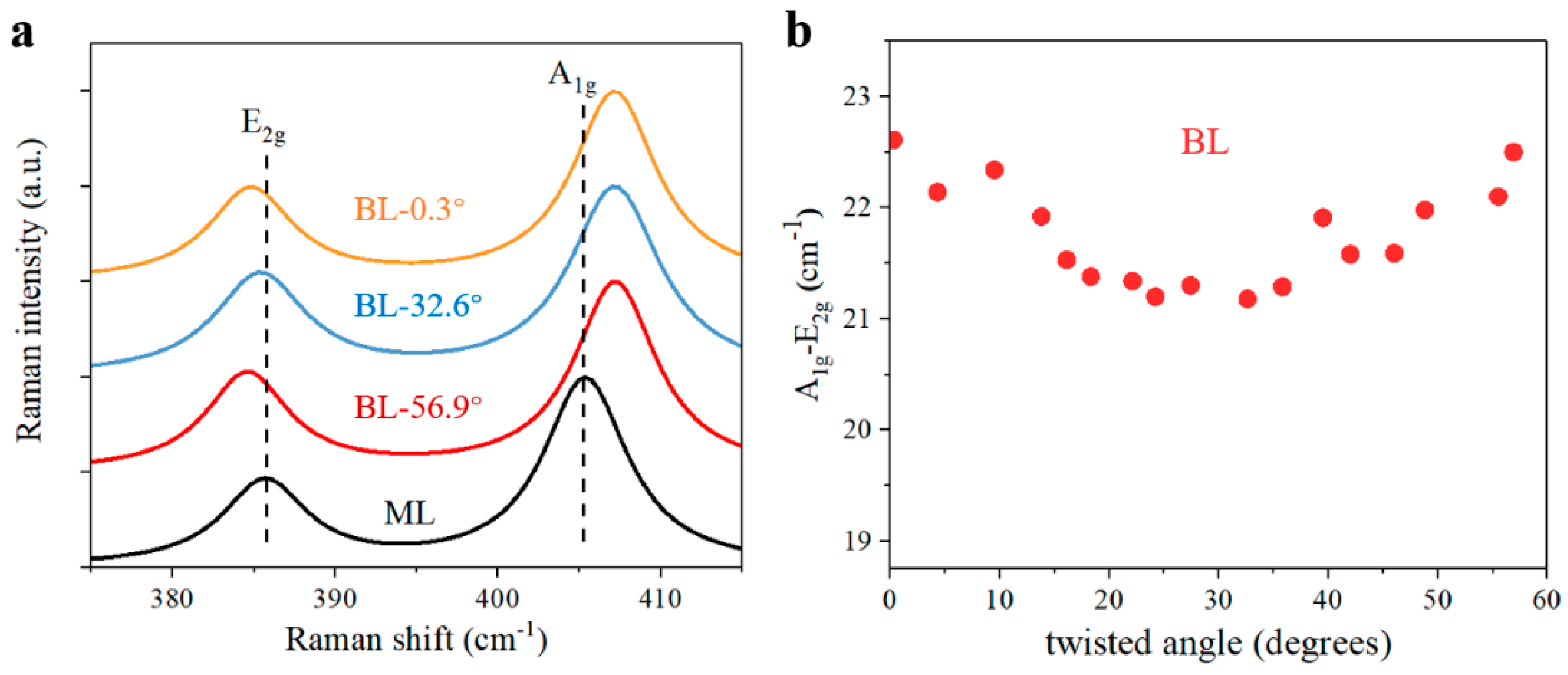

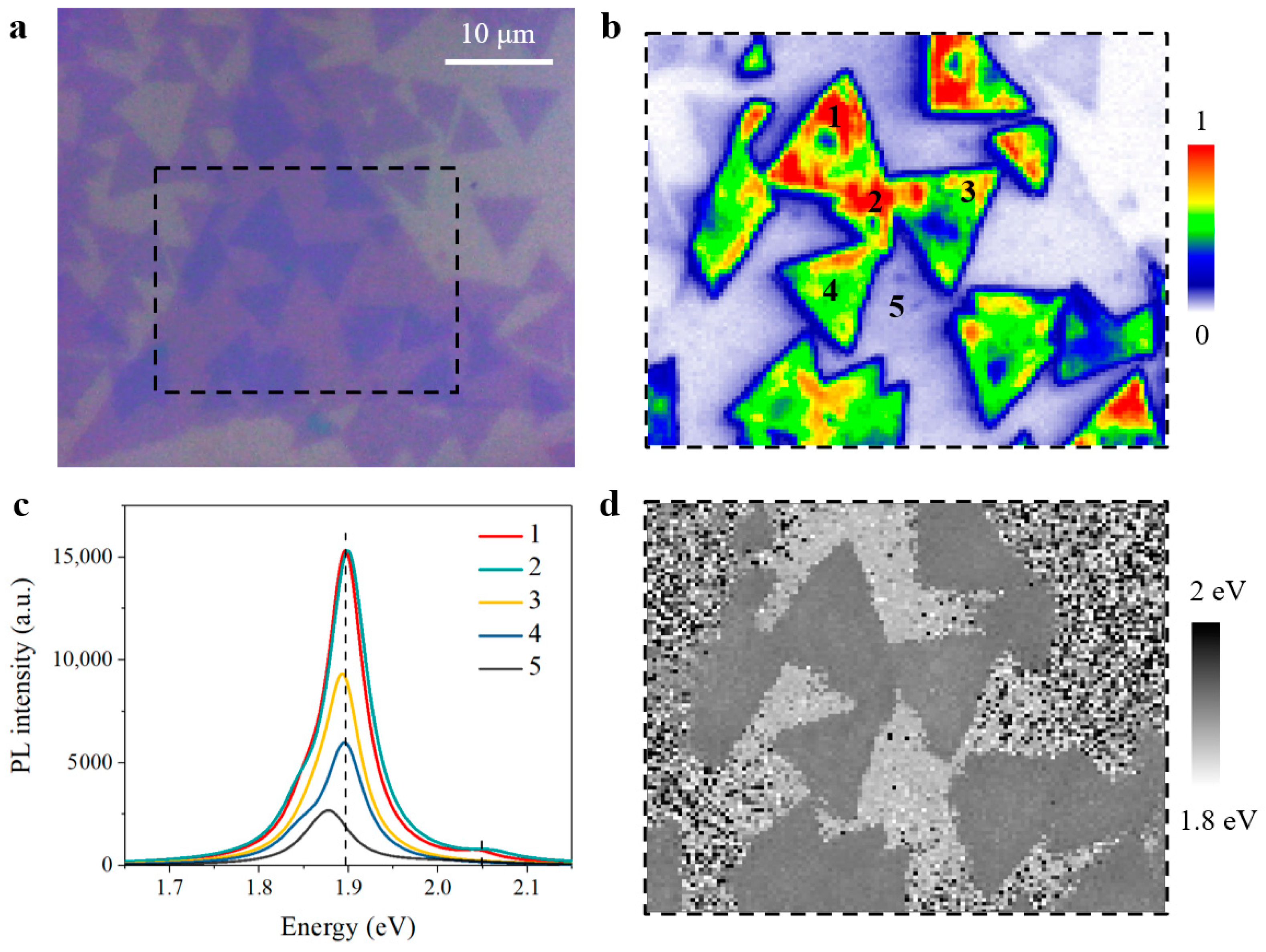
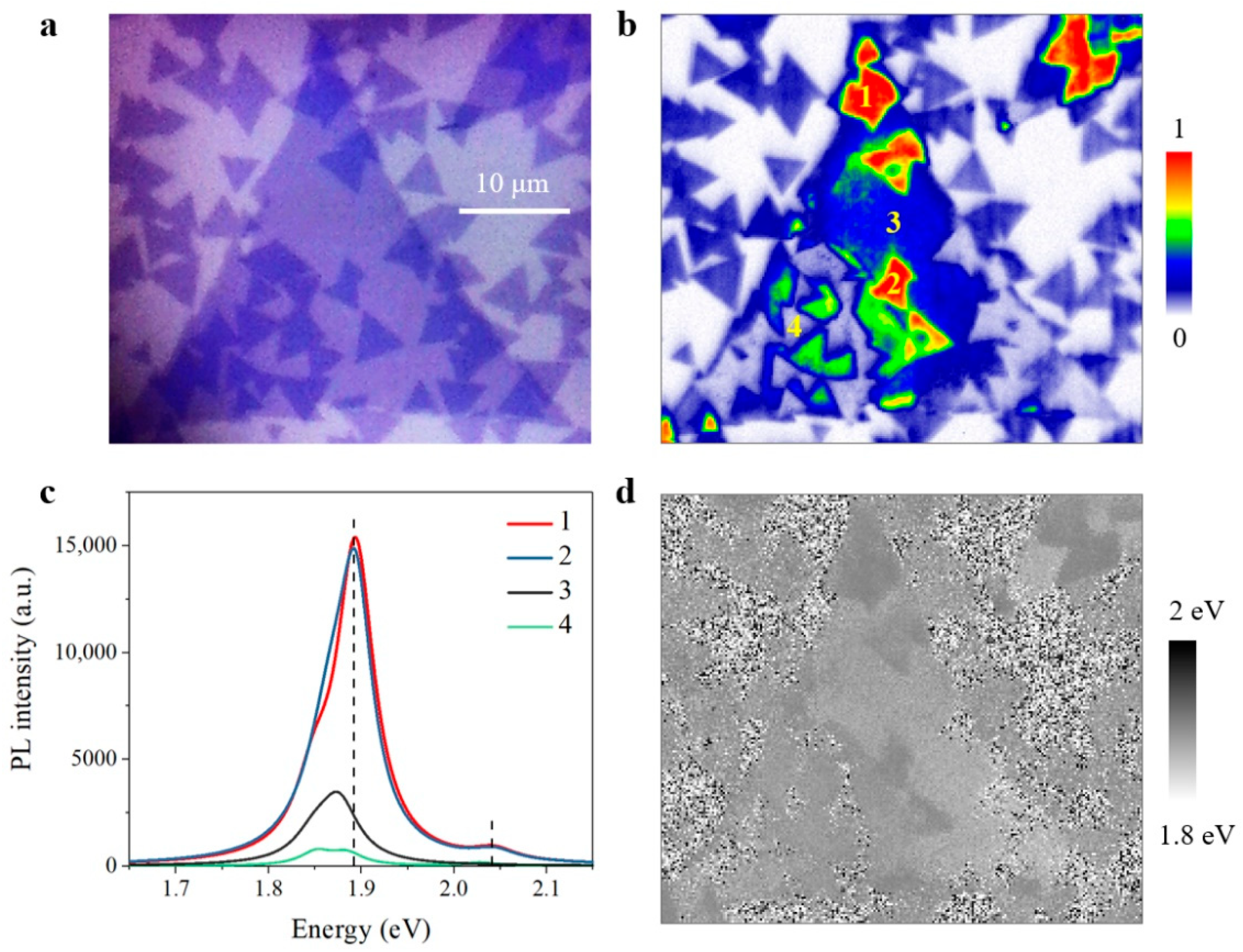
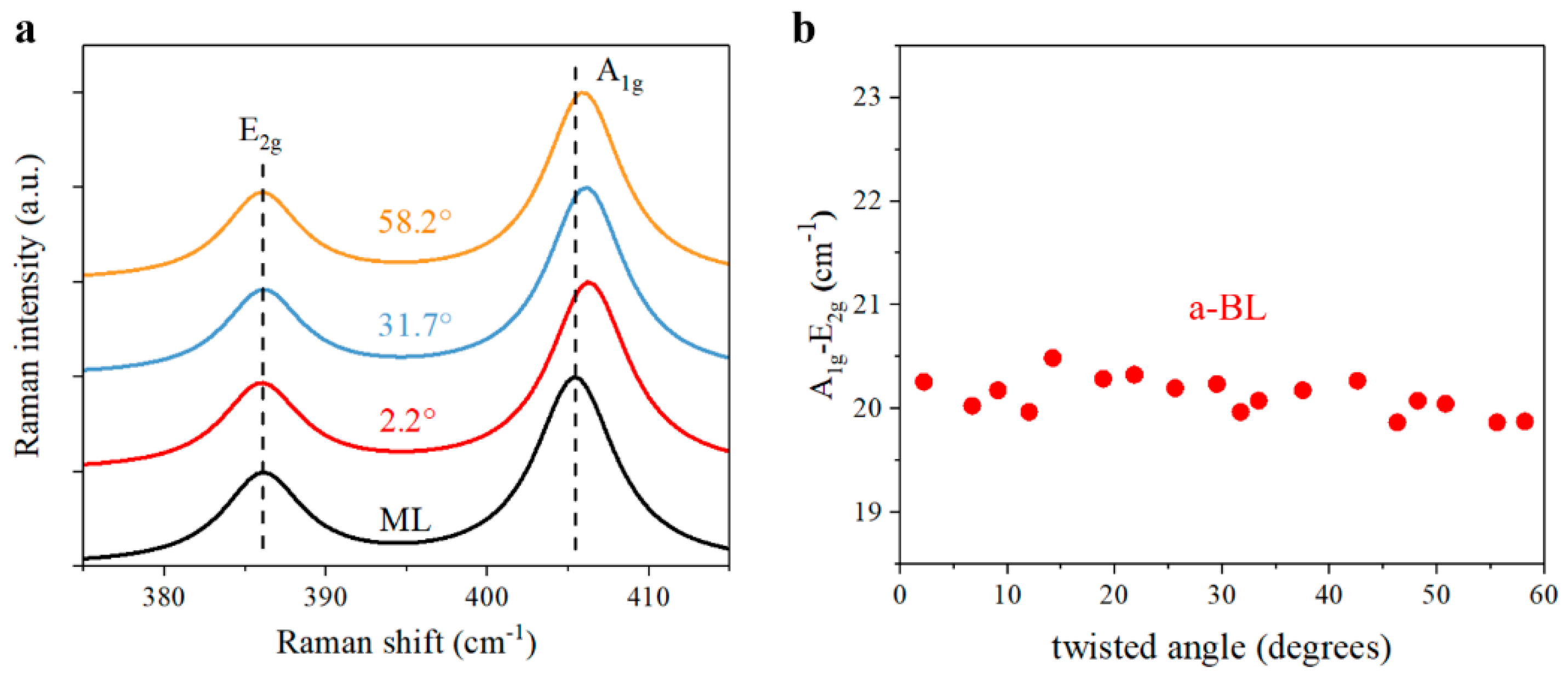
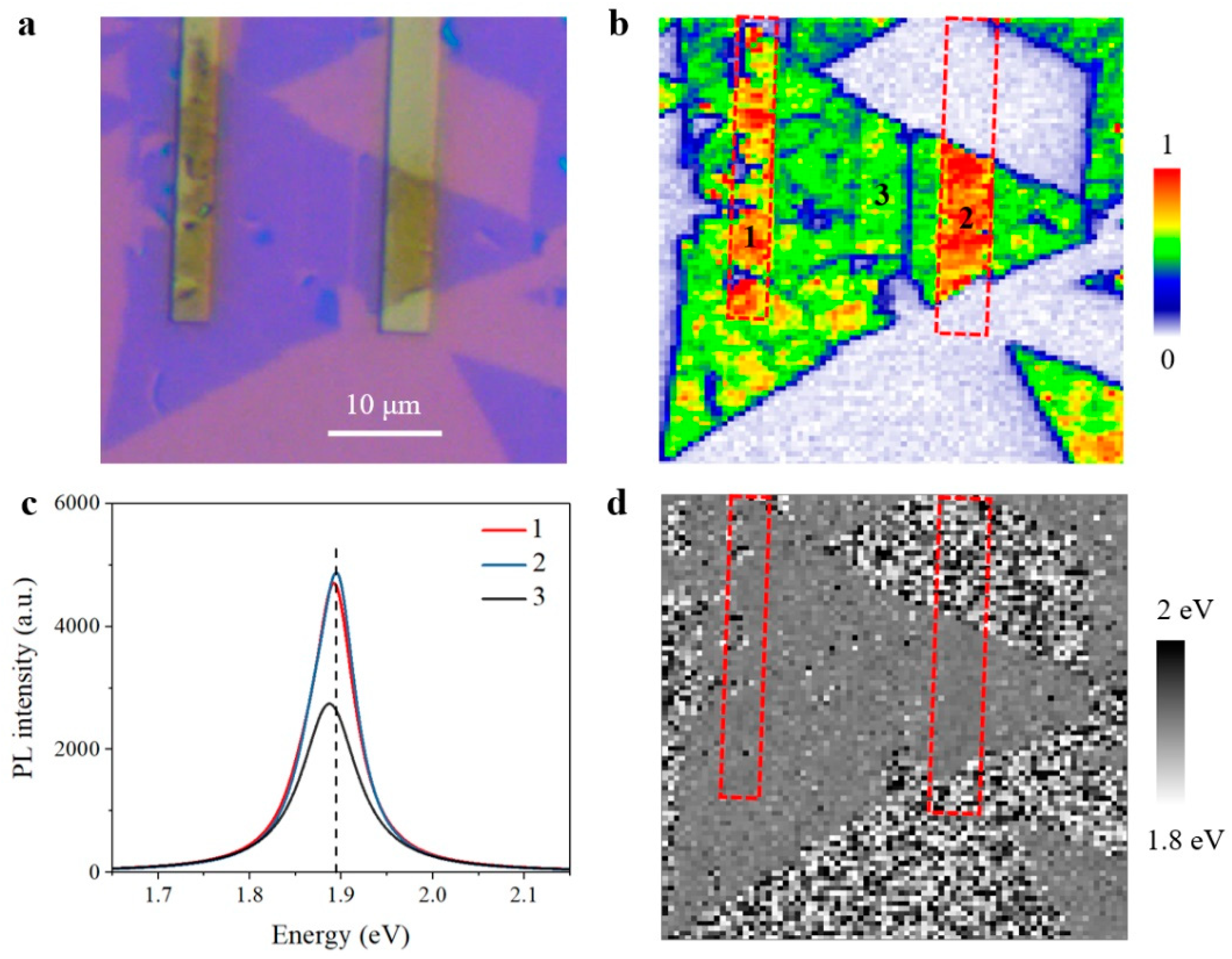

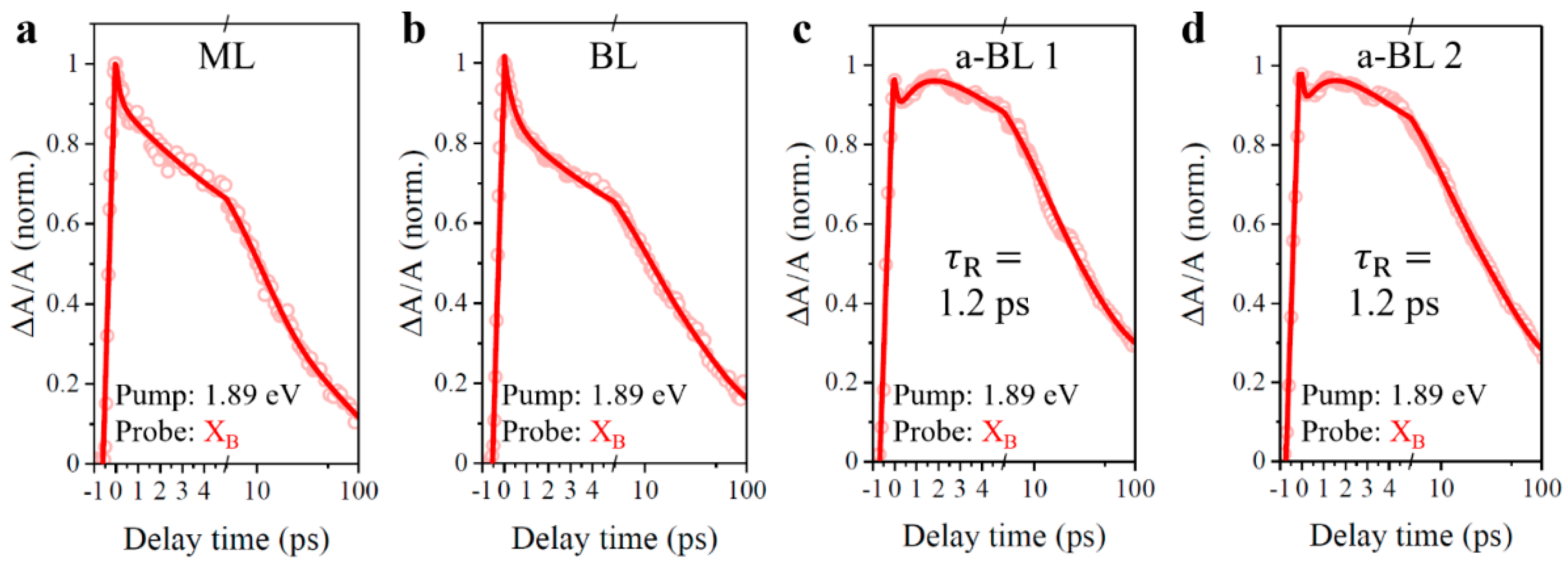



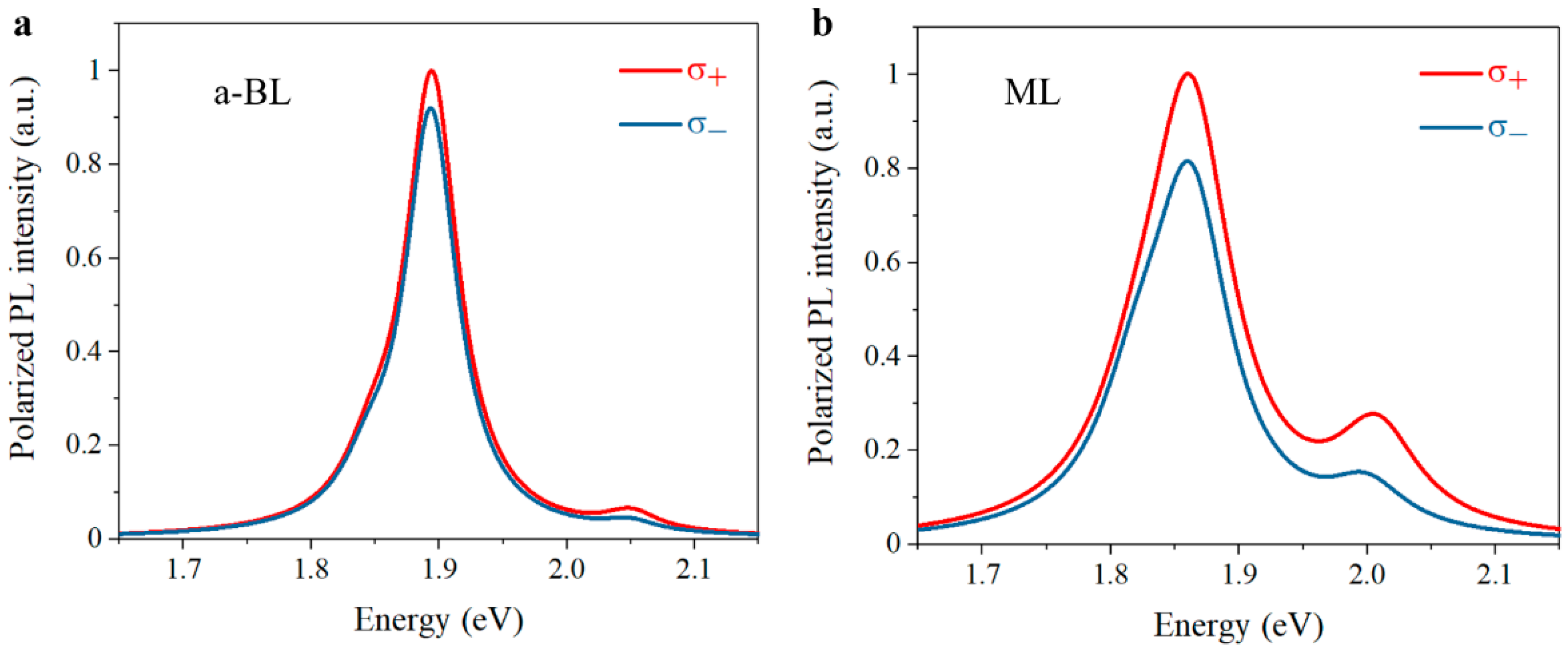
| Item | ML | BL | a-BL 1 | a-BL 2 | ||||
|---|---|---|---|---|---|---|---|---|
| XB | XA | XB | XA | XB | XA | XB | XA | |
| (ps) | 0.2 (19%) | 0.2 (18%) | 0.2 (20%) | 1.95 (13%) | 0.1 (10%) | 0.5 (10%) | 0.1 (11%) | 0.3 (17%) |
| (ps) | 9.5 (40%) | 2.4 (36%) | 7.1 (43%) | 4.4 (41%) | 10 (47%) | 8.14 (48%) | 11.2 (41%) | 7.3 (37%) |
| (ps) | 26 (25%) | 18.8 (31%) | 31 (29%) | 20.2 (37%) | 29.7 (39%) | 50.9 (34%) | 29.4 (40%) | 46 (33%) |
| (16%) | (15%) | (8%) | (9%) | (8%) | (13%) | |||
| (ps) | 1.3 (25%) | 1.3 (26%) | ||||||
| Item | ML | BL | a-BL 1 | a-BL 2 |
|---|---|---|---|---|
| XB | XB | XB | XB | |
| (ps) | 0.2 (10%) | 0.4 (13%) | 0.2 (12%) | 0.1 (10%) |
| (ps) | 9.6 (44%) | 7.5 (35%) | 8.5 (42%) | 7.4 (39%) |
| (ps) | 69.6 (32%) | 41.8 (39%) | 39.2 (46%) | 43.2 (49%) |
| (14%) | (13%) | |||
| (ps) | 1.2 (26%) | 1.2 (23%) |
| Item | Supported ML (2.2 eV pump) | Suspended ML (2.2 eV pump) | Supported ML (1.89 eV pump) | Suspended ML (1.89 eV pump) | ||
|---|---|---|---|---|---|---|
| XB | XA | XB | XA | XB | XB | |
| (ps) | 0.2 (20%) | 0.4 (20%) | 0.1 (7%) | 0.6 (17%) | 0.3 (12%) | 0.2 (11%) |
| (ps) | 1.3 (34%) | 2.7 (37%) | 12 (47%) | 8.1 (31%) | 7.5 (45%) | 7.4 (44%) |
| (ps) | 26.7 (25%) | 24.5 (30%) | 64.9 (46%) | 64 (38%) | 49.3 (35%) | 44.9 (45%) |
| (21%) | (13%) | (14%) | (8%) | |||
| (ps) | 1.3 (17%) | 1.4 (18%) | ||||
Publisher’s Note: MDPI stays neutral with regard to jurisdictional claims in published maps and institutional affiliations. |
© 2021 by the authors. Licensee MDPI, Basel, Switzerland. This article is an open access article distributed under the terms and conditions of the Creative Commons Attribution (CC BY) license (https://creativecommons.org/licenses/by/4.0/).
Share and Cite
Li, H.; Ma, Y.; Xu, Z.; Cheng, X.; Jiang, T. Giant Photoluminescence Enhancement and Carrier Dynamics in MoS2 Bilayers with Anomalous Interlayer Coupling. Nanomaterials 2021, 11, 1994. https://doi.org/10.3390/nano11081994
Li H, Ma Y, Xu Z, Cheng X, Jiang T. Giant Photoluminescence Enhancement and Carrier Dynamics in MoS2 Bilayers with Anomalous Interlayer Coupling. Nanomaterials. 2021; 11(8):1994. https://doi.org/10.3390/nano11081994
Chicago/Turabian StyleLi, Han, Yating Ma, Zhongjie Xu, Xiang’ai Cheng, and Tian Jiang. 2021. "Giant Photoluminescence Enhancement and Carrier Dynamics in MoS2 Bilayers with Anomalous Interlayer Coupling" Nanomaterials 11, no. 8: 1994. https://doi.org/10.3390/nano11081994
APA StyleLi, H., Ma, Y., Xu, Z., Cheng, X., & Jiang, T. (2021). Giant Photoluminescence Enhancement and Carrier Dynamics in MoS2 Bilayers with Anomalous Interlayer Coupling. Nanomaterials, 11(8), 1994. https://doi.org/10.3390/nano11081994






